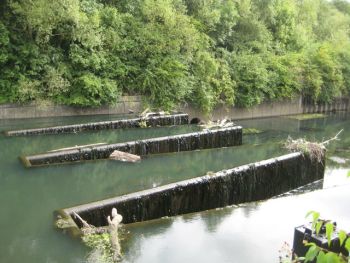Labyrinth Spillways: Difference between revisions
(Created page with "__NOTOC__ Category:Spillway Control Structures ---- “The flow capacity of a weir is largely governed by the weir length and crest shape. A labyrinth weir is a linear weir folded in plan-view; these structures offer several advantages when compared to linear weir structures. Labyrinth weirs provide an increase in crest length for a given channel width, thereby increasing flow capacity for a given upstream head. As a result of the increased flow capacity, these weirs...") |
No edit summary |
||
| Line 2: | Line 2: | ||
[[Category:Spillway Control Structures]] | [[Category:Spillway Control Structures]] | ||
---- | ---- | ||
{{Picture | |||
<!-- Add image file name (ex.image.jpg) --> | |||
|image= Lock_Labyrinth_Weir.jpg | |||
<!--Add link if applicable --> | |||
|link= | |||
<!-- Add picture caption --> | |||
|caption= Labyrinth Weir, London. | |||
(Image Source: [https://commons.wikimedia.org/wiki/File:River_Brent,_Osterley_Lock_Labyrinth_Weir_-_geograph.org.uk_-_3617042.jpg Wikimedia]) | |||
}} | |||
“The flow capacity of a weir is largely governed by the weir length and crest shape. A labyrinth weir is a linear weir folded in plan-view; these structures offer several advantages when compared to linear weir structures. Labyrinth [[weirs]] provide an increase in crest length for a given channel width, thereby increasing flow capacity for a given upstream head. As a result of the increased flow capacity, these weirs require less free board in the upstream reservoir than linear weirs, which facilitates flood routing and increases reservoir storage capacity under base flow conditions (weir height may be increased). In addition to [[spillways]], labyrinth weirs are also effective drop structures, energy dissipaters, and flow aeration control structures."<ref name="Crookston">[[Labyrinth Weirs, Dissertation by Brian Crookston, Utah State University|Labyrinth Weirs, Dissertation by Brian Crookston, Utah State University, 2010]]</ref> | “The flow capacity of a weir is largely governed by the weir length and crest shape. A labyrinth weir is a linear weir folded in plan-view; these structures offer several advantages when compared to linear weir structures. Labyrinth [[weirs]] provide an increase in crest length for a given channel width, thereby increasing flow capacity for a given upstream head. As a result of the increased flow capacity, these weirs require less free board in the upstream reservoir than linear weirs, which facilitates flood routing and increases reservoir storage capacity under base flow conditions (weir height may be increased). In addition to [[spillways]], labyrinth weirs are also effective drop structures, energy dissipaters, and flow aeration control structures."<ref name="Crookston">[[Labyrinth Weirs, Dissertation by Brian Crookston, Utah State University|Labyrinth Weirs, Dissertation by Brian Crookston, Utah State University, 2010]]</ref> | ||
Revision as of 15:01, 25 July 2023

|
| Labyrinth Weir, London.
(Image Source: Wikimedia) |
“The flow capacity of a weir is largely governed by the weir length and crest shape. A labyrinth weir is a linear weir folded in plan-view; these structures offer several advantages when compared to linear weir structures. Labyrinth weirs provide an increase in crest length for a given channel width, thereby increasing flow capacity for a given upstream head. As a result of the increased flow capacity, these weirs require less free board in the upstream reservoir than linear weirs, which facilitates flood routing and increases reservoir storage capacity under base flow conditions (weir height may be increased). In addition to spillways, labyrinth weirs are also effective drop structures, energy dissipaters, and flow aeration control structures."[1]
Citations:
Revision ID: 7438
Revision Date: 07/25/2023
